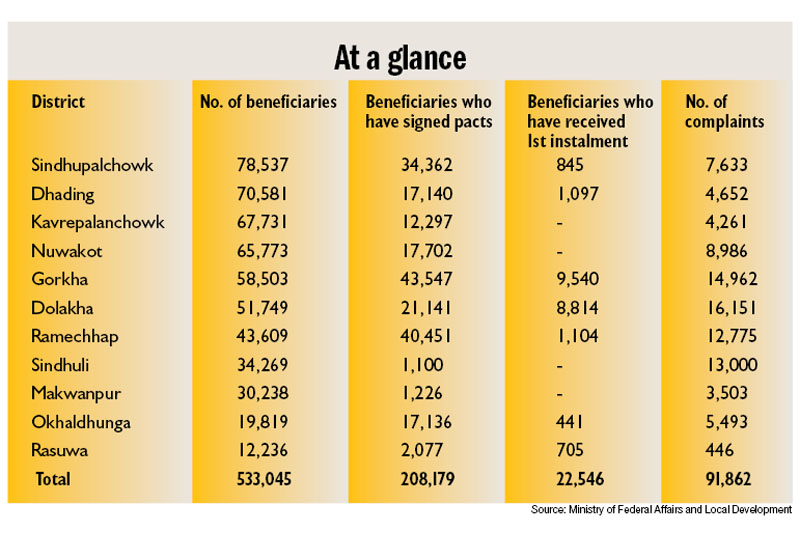Grant distribution for quake survivors moving at snail’s pace
The process of distributing first instalment of housing grant for earthquake survivors is moving ahead at a snail’s pace, with the National Reconstruction Authority (NRA) being able to extend the amount to only 11 per cent of beneficiaries with whom grant agreements have been signed.
So far, 533,045 households have been found eligible for housing grant of Rs 200,000, which is being extended in three instalments of Rs 50,000, Rs 80,000 and Rs 70,000. Of these households, located in 11 of the 14 districts hit hard by earthquakes of April and May in 2015, 208,179 have entered into agreements with concerned local bodies.
But as of today only 22,546, or 10.8 per cent, beneficiaries, who have signed agreements, have received the first instalment of Rs 50,000, show the data provided by the Ministry of Federal Affairs and Local Development (MoFALD).
Worse, the process of distributing first instalment of grant has not even begun in four districts, namely Kavrepalanchowk, Sindhuli, Nuwakot and Makwanpur.
“We know many people, with whom agreements have been signed, have not received the first instalment. This is largely because most of the branches of banks and financial institutions are located in accessible areas, while many beneficiaries live in far-flung places,” NRA Spokesperson Ram Prasad Thapaliya said.
This delay has forced a majority of the quake survivors to spend days and nights in temporary shelters. Now, it is almost certain even people, who have received the first instalment of the grant, will remain stuck in those shelters throughout ongoing monsoon, as they will not get adequate time to build new houses.
The MoFALD data also show that NRA has been taking quite a long time to sign agreements with households who are considered eligible for grant.
For instance, in Sindhupalchowk, where highest number of 78,537 beneficiaries has been identified, agreements have been signed with only around 44 per cent of households. In Dhading and Kavrepalanchowk, agreements have been signed with 24 and 18 per cent of identified beneficiaries, respectively.
The situation is even worse in Sindhuli and Makwanpur districts where agreements have been signed with less than five per cent of identified beneficiaries.
With the delay in agreement signing process, grant distribution process has also been affected, as only the households that have entered into pact will be eligible for first instalment.
The NRA formally began the process of distributing the first instalment of the grant on March 13. But the process was later suspended, as the NRA could not make necessary arrangements to distribute the funds through the banking channel in all the districts.
Then finally in the last week of May, the NRA entered into agreements with Nepal Bankers’ Association, Development Bankers’ Association Nepal and Nepal Financial Institutions Association to mobilise commercial banks, development banks and finance companies to distribute the grant amount.
As per the pact, banks and financial institutions (BFIs) had to create working areas and distribute the grant amount in places designated for them. Based on these clusters, BFIs had to open zero-deposit accounts (in the name of concerned beneficiaries) to enable concerned local bodies to deposit the first instalment of the grant amount.
“But since BFIs couldn’t create clusters on their own, we had to ask district coordination committee, which also comprises chief district officer and local development officer, to perform this task,” said Thapaliya. “Now this task has been completed and BFIs have started opening zero-deposit accounts. So, we hope the process of depositing first instalment will move ahead swiftly.”






